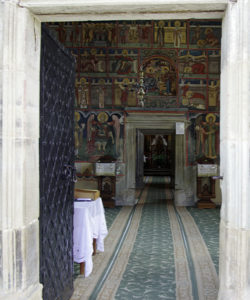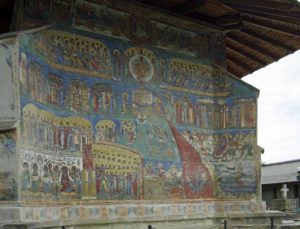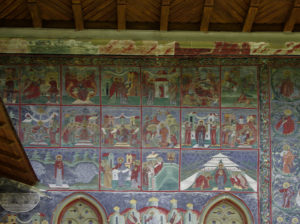Bucovina is a rich landscape of mountains, river valleys forests, farmland and small settlements to the north of the Carpathian Mountains and the Ukrainian border.
In the Middle Ages, Moldavia which included Bucovina, served as a buffer zone for the Hungarian Empire against attacks by the Tatars. In the mid C14th Stephen the Great secured the throne of Moldavia with help from Prince Vlad (the Impaler) of Transylvania, with the intention of establishing Moldova as a strong and independent principality. Although his kingdom was subjected to many attacks by the Ottomans, Turks and others, he secured the frontiers of his country by building fortresses and strengthening central power. He commemorated victory in battle by building a new monastery, reinforcing the dominance of the Orthodox faith.
He was succeeded by his illegitimate son, Petru Rares who was responsible for the exterior decoration of the monasteries.
The monasteries were surrounded by walls with towers and were built isolated places. Gradually villages grew up around them attracted by the protection they offered in unsettled times as well as their relative prosperity.
Gradually the monastery became and integral part of the community. They provided schools and infirmaries. Many were also important centres of learning and also had workshops for embroidery, calligraphy, manuscript illumination, icon painting as well as gold and silverwork.
Anyone could become a monk or nun. They started by becoming a novice for three to five years depending on their level of dedication. They were then appointed as a brother or sister for another ten years before finally becoming a monk or nun, when they were assigned a specific role in the community.
Monasteries were self supporting communities with the monks and nuns growing all their food, foraging for nuts, berries and fungi, tending animals and cutting wood for heating and cooking. Their life was also controlled by the times of religious services with the day starting at vespers in the evening.
The church was at the heart of the monastic community and was surrounded by a tall protective wall with towers. Inside were domestic buildings needed for the smooth running of the community. These included the abbot’s house, cells for monks or nuns, refectory, kitchens and store houses. Outside the walls were the servants quarters, stabling for horses and hay barns as well as the cemetery.
The churches were all built to the same triconch pattern with tall walls and a dome. They were traditionally divided into three parts; the PRONAOS which was used by the local community, and now often has a small stall selling candles. The NAOS (or nave) was used by he monks and nuns and had small apses off the north and south walls and the dome above. The CHANCEL at the east end was separated from the Naos by the ICONOSTASIS. This had three doors and only the priest could use the central door. Less important clergy used the side doors. This contained the high altar with two sacristies off it. That on the south was for storing Holy vessels. The north was used for the preparation for the Eucharist.
The icons on the iconostasis are arranged in a strict order. On either side of the doors are the ‘Imperial Icons’ which include the Virgin, Christ and the patron saint of the church. Above these are icons depicting religious feast days. The middle one is usually the Last Supper. Above these are the apostles and prophets. At the top is a crucifix with the Virgin and John the Baptist.
Later an EXONARTHEX or porch was added to the west end. This was either open or closed. Sometimes and additional chamber was added between the pronaos and naos. This was described as the Burial Chamber where the founder of the church and his family were buried, princes or important noblemen.
The inside of the churches are covered with paintings. The chancel walls are covered with scenes from the life of Christ. The dome above the naos represents heaven with the nine orders of angels with Christ at the centre of the dome.
The noas displays Christ’s Passion. The burial chamber and pronaos have the Menology which is the calendar of festivals celebrated throughout the year in honour of the different saints and martyrs. The exonarthex represents the transition from the lay world and the sacred space of the church with the theme of the salvation of the righteous and the damnation of sinners and infidels with a gruesome selection of martyrdoms.
The Painted monasteries are nearly all found only in Bucovina. When they were first built by Stephen the Great the external walls were left plain apart from small paintings above doors and gateways. The main period of painting was during the reign of Petru Rares between 1530-50.
The paintings were applied directly onto wet lime rendering which was spread across the walls Only a limited area could be painted each day. The artist first sketched the outline before filling in the background, Azurite blue was used for the sky and malachite green for the ground. The landscape and buildings were painted on next using different hues of clay earth pigments, like red and yellow ochre. The figures were the last to be painted. As the rendering dried, it bound the pigments to form a durable layer. Large overhanging eaves were designed to throw rain and snow away from the walls.
The paintings follow the same principles. On the apse at the east end is the ‘Prayer of the Saints’ with rows of angels, prophets, apostles, saints and martyrs on either side of the central figures of God, the Virgin and Christ.
On the south facade is the Tree of Jesse which shows the descent of Christ from King David. The different figures are the ancestors of Christ. Below this are the ‘Pagan Philosophers’ including Socrates, Plato, Aristotle, Pythagorus, Thucydides, Homer and Sibyl. In their writings, the Church found allusions and prophecies to the coming of Christ.
Along the top is ‘Akathistos Hymn’ which is a devotional poem singing the praises of the Virgin Mary and is sung in all Orthodox Churches on the five Fridays in Lent. The poem contains twenty four stanzas. The first twelve stanzas and pictures have images from the life of the Virgin from the annunciation to the presentation of Jesus in the temple. The last twelve sing praises to the glory of the Virgin.
Some churches also have Moses and the Burning Bush, or the Vision of Moses, which is often considered part of the Akathistos Hymn. This tells how the Virgin appeared to Moses in a Burning Bush, symbolising her perpetual virginity that cannot be consumed by fire. The Bush is often represented by a big rock crowned with flowers from which rise the figures of the Virgin and Christ.
Often depicted at the bottom west corner is the Siege of Constantinople in 626AD. The fortress is being attacked from the land and sea by Turks, Inside the walls, the citizens are carrying icons with images of the Virgin and Christ. Their prayers cause God to send thunder and rain and the sea drowning the attackers.
The west facade has the Last Judgement, with saints, Holy people and churchmen among the saved and infidels among the damned. The red river of Hell engulfs the figures of the damned. It is designed to concentrate the minds of those entering the church on the fate awaiting those who stray from the way of righteousness and the rewards of the righteous.
Each of the monasteries is different and they are stunning. “Moldovita,”:http://wasleys.org.uk/eleanor/otherholidays/romania/day_six/six_two/index.html “Sucevita”:http://wasleys.org.uk/eleanor/otherholidays/romania/day_six/six_three/index.html and “Voronet”:http://wasleys.org.uk/eleanor/otherholidays/romania/day_six/six_four/index.html can all be visited as part of a long day from Guru Humorului. They do get a lot of visitors and can be very busy. There is a small charge to visit and 10Lei charge to take photographs of the outside of the buildings. Photography is not allowed inside.
We visited as part of a ten day trip to Romania. My detailed report with all the pictures can be found “here.”:http://wasleys.org.uk/eleanor/otherholidays/romania/index.html










